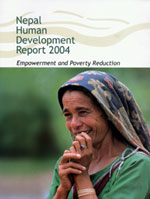 UNDP's annual Human Development Report released on Wednesday hopes to put the debate about which comes first, peace or development, finally to rest.
UNDP's annual Human Development Report released on Wednesday hopes to put the debate about which comes first, peace or development, finally to rest. The report, titled 'Empowerment and poverty reduction' says: 'Facing the worst crisis in its modern history, the country must take a critical step further and place the empowerment of its citizens at the centre of human development." Despite the post-1990 achievements in education and health, economic growth and investment, a vibrant press and increased awareness among the marginalised groups about their condition, the report says these advances have not yet reduced the powerlessness of a vast majority of Nepalis.
How to go about it when a conflict is raging? The report has drawn up a Human Empowerment Index which traces a countour map of exclusion and marginalisation of communities in Nepal. The map shows that mid and far-western hills are the least empowered regions of Nepal and this is manifested in its underdevelopment. The report says this disenfranchisement and neglect has led to grievances that have piled up and erupted in conflict.
The report also carries a study of UNDP's own social mobilisation efforts in the past decade and the conclusion that local democracy and participation in decision-making can break the cycle of poverty and empower grassroots communities. The report was prepared by Sriram Raj Pande, Bikash Sharma and Dilli Raj Khanal with a team of advisers and consultants for UNDP. The report concludes that Nepal's macroeconomic health has not acted as a locomotive to promote pro-poor growth in the country.
Pande was involved in the report's prescription of the future, contained in a nine-point checklist, which include:
. Deepening democracy
. Removing discriminatory laws
. Pro-poor macro-economic reforms
. Stress on agriculture
. Equitable health and education
. Infrastructure
. Employment
. Empowering the marginalised
. Investing in the poor


